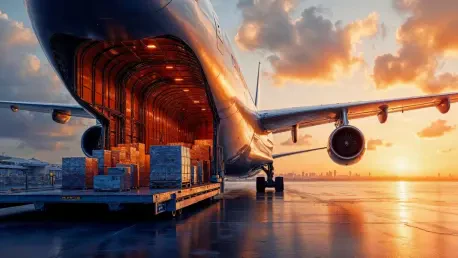Welcome to an insightful conversation with Rohit Laila, a seasoned veteran in the logistics industry with decades of experience spanning supply chain management and delivery. Rohit’s expertise and passion for technology and innovation make him a leading voice in air cargo freight forwarding. In this interview, we dive into the complexities of the upcoming air cargo peak season, the challenges of market predictability, capacity constraints in the industry, strategic growth through acquisitions, and the push for sustainability in airfreight operations. Join us as we explore how these dynamics are shaping the future of logistics.
How do you see the air cargo peak season unfolding for the industry, and what unique challenges are you bracing for?
The peak season is always a critical time for us in air cargo, and this year, I anticipate a mixed bag of opportunities and hurdles. On one hand, supply chain disruptions—like those caused by tariff uncertainties—can drive a spike in demand as companies rush to move goods quickly. On the other, we’re seeing a slowdown in demand more recently, which makes me cautious about overly optimistic year-end forecasts. The biggest challenge is balancing these stop-and-go patterns; some weeks are incredibly busy as clients preempt decisions, and then suddenly, activity drops. It’s a rollercoaster, and we’re preparing by staying agile and ensuring we can pivot to meet urgent airfreight needs when they arise.
What role do you think recent tariff policies might play in shaping demand during this peak period?
Tariff announcements, especially from the U.S., have created a lot of uncertainty in the supply chain. Companies are trying to get ahead of potential cost increases by moving goods early, which leads to these erratic bursts of activity. If this continues, it could fuel demand for airfreight during peak season as businesses prioritize speed to avoid delays or higher costs. However, if inventories are already stocked up due to these early movements, we might see weaker demand later if consumer spending doesn’t pick up. It’s a delicate balance, and we’re keeping a close eye on policy developments to adjust our strategies accordingly.
Can you elaborate on the current slowdown in demand and how it’s influencing your expectations for the end of the year?
The slowdown we’ve noticed in recent weeks has been a bit of a surprise after a period of relative stability. It seems to stem from a combination of overstocked inventories in key markets like the U.S. and broader economic uncertainties impacting consumer behavior. This stop-and-go rhythm disrupts planning, and it’s made us more conservative about our year-end outlook. While we still expect a peak season bump, I’m not as bullish as I was a month ago. We’re focusing on flexibility—ensuring we can scale up or down based on real-time demand signals.
Turning to market visibility, what specific factors are making it so tough to predict trends right now?
Visibility is probably the biggest headache for the industry at the moment. There’s just so much uncertainty—whether it’s fluctuating economic indicators, geopolitical tensions, or policy shifts like tariffs. In the U.S., for instance, companies are stockpiling early to dodge potential cost hikes, but if the economy slows, they’re left with excess inventory and no need to ship more. Add to that global GDP growth concerns, and it’s like trying to forecast the weather in a storm. We’re relying heavily on data analytics and close client communication to piece together a clearer picture, but it’s an ongoing challenge.
How does the U.S. market stand out as particularly difficult to forecast compared to other regions?
The U.S. market is uniquely tricky because of its size and the ripple effects of its policies. With tariff changes looming, businesses are making big moves to secure inventory, which creates short-term spikes in demand. But if consumer spending dips—or if it surges unexpectedly—those inventories could either sit idle or deplete rapidly, leading to unpredictable shipping needs. Compared to other regions, the U.S. has a more pronounced impact on global supply chains, so the stakes are higher. We’re constantly adjusting our approach here, whereas in other areas, trends can be a bit more stable or localized.
You’ve mentioned growth in regions like Latin America, Southeast Asia, and Eastern Europe. What’s fueling demand in these areas?
I’m really excited about the potential in these emerging markets. In Latin America, we’re seeing strong demand driven by industrial growth and increasing trade ties. Southeast Asia continues to be a manufacturing powerhouse, with countries ramping up exports, especially in electronics and textiles. Eastern Europe, along with places like Turkey, is benefiting from being near key trade routes and offering cost-effective production options. Despite global uncertainties, these regions are showing resilience and attracting investment, which translates into more freight movement. It’s a bright spot for us, and we’re investing to strengthen our presence there.
Shifting to capacity, how are you managing to secure enough airfreight capacity amidst fluctuating demand?
Securing capacity in this environment is all about strong partnerships and strategic planning. We maintain a robust network with carriers who’ve committed to supporting us even during volatile periods. We’re also continuing to operate our own air charter network, though it’s scaled back from the intense levels we saw during the COVID crisis. Right now, the market has enough capacity to meet moderate demand, but we’re prepared to ramp up if unexpected surges hit. It’s about staying proactive—locking in agreements early and keeping open lines with our partners to handle any surprises.
Looking ahead, what concerns do you have about widebody freighter capacity, and how might this impact the industry if demand spikes?
I’m increasingly worried about widebody freighter capacity in the long term. The fleet is aging, and there aren’t enough new aircraft coming into service to replace them. On top of that, pilot shortages are becoming a real issue, which could limit how many flights we can operate. If demand stays moderate, we can manage, but a sudden peak could strain the system significantly. This could lead to higher costs, delays, and a scramble for available slots. The industry needs to address these bottlenecks—whether through investment in new aircraft or training programs for pilots—to avoid a crisis down the line.
On the topic of growth strategies, how do you approach acquisitions to strengthen your position in the market?
Acquisitions are a key part of our growth strategy, but we’re very deliberate about them. Our focus is on bolt-on purchases that enhance our strengths in specific verticals like aerospace, luxury goods, or automotive. We’re not chasing giants; instead, we look for solid opportunities that align with our long-term goals. For instance, integrating specialized firms allows us to deepen expertise and expand our service offerings. We’re always scanning the market for the right fit, and with a supportive shareholder backing us, we’re in a good position to invest when the opportunity arises.
Sustainability is a growing focus in logistics. Can you share how you’re tackling emissions reduction in airfreight operations?
Sustainability is non-negotiable for us, and we’re taking innovative steps to cut emissions in airfreight. We’ve developed solutions focused on efficiency, like optimizing aircraft selection and routing to minimize greenhouse gas output. This approach can reduce emissions significantly—sometimes by up to 30%—and it’s a more cost-effective alternative to options like Sustainable Aviation Fuel, which hasn’t gained as much traction with clients. We’re also investing in data analytics to fine-tune these efforts. It’s about finding practical ways to balance environmental goals with operational realities, and I’m proud of the progress we’re making.
Finally, what is your forecast for the air cargo industry over the next few years, considering the challenges and opportunities you’ve discussed?
Looking ahead, I think the air cargo industry will continue to face a complex landscape. On the positive side, emerging markets and technological advancements will drive growth and efficiency. However, challenges like capacity constraints, economic volatility, and sustainability pressures will test our resilience. I expect demand to remain uneven, with sharp peaks and troughs influenced by global events. My forecast is cautiously optimistic—we’ll see steady growth if we can address capacity and workforce issues, but adaptability will be key. Companies that invest in innovation and strong partnerships will be best positioned to thrive in this evolving environment.









